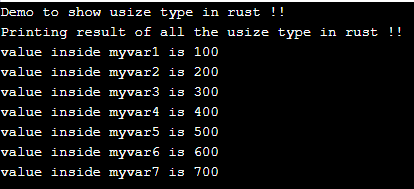Updated June 1, 2023
Introduction to Rust usize
It is a primitive type of rust based on a pointer like C programming language. If we have a type that does not have a definite size, we call those primitive types ‘usize’ in rust or dynamically sized types in rust. It is represented as the pointer sized unsigned type in rust. The number of bytes required to represent any one of the memory locations can be used to determine the size of this type. This cannot be predicted at the compile time; it can only be done at the runtime because it does not know how many bite or bytes it will take because it is also termed a dynamic size integer. In the coming section, we will discuss more the usize in rust, how they work, and how they should be implemented in the program in detail.
Syntax
As mentioned earlier, we use usize to represent the integer value of the variable. Let’s take a look at its syntax and how to define use in Rust for better understanding for beginners see below;
let variable_name:usize = integer_value;As you can see in the above lines of syntax, we declare the usize variable; for this, we are defining a variable by using the type in rust. Let’s take a practice syntax for better understanding for beginners see below;
Example:
let demo:usize = 10;Simply assign the value to the usize variable here; in the coming section, we will discuss the internal working of the usize type in rust; this will help beginners see this while programming efficiently for better usage.
How usize function works in Rust?
usize is the type of Unsigned integer in rust; they are meant to deal with integers in rust. Also, they allow positive integers only. We have several types available for unsigned integers, out of which usize is one of them, it stores the integer, or its size, in the form of an arch. That means the size of the type is going to determine by the architecture of the machine. This means we can say dynamic sized type. Let’s discuss the various type of unsigned integers in detail for better understanding, see below;
1. usize: The size’s usize is determined by the arch size, a pointer-based type integer. Below we can see the syntax to define and use them while programming in Rust see below;
Example:
let demo:usize = 10;2. u8: This unsigned integer type size stands for 8 bit. Below we can see the syntax to define and use them while programming in Rust see below;
Example:
let demo:u8 = 10;3. u16: This unsigned integer type size stands for 16 bit. Below we can see the syntax to define and use them while programming in Rust see below;
Example:
let demo:u16 = 10;4. u32: This unsigned integer type size stands for 32 bit. Below we can see the syntax to define and use them while programming in Rust see below;
Example:
let demo:u32 = 10;5. u64: This unsigned integer type size stands for 64 bit. Below we can see the syntax to define and use them while programming in rust see below;
Example:
let demo:u64 = 10;6. u128: This unsigned integer type size stands for 128 bit. Below we can see the syntax to define and use them while programming in rust see below;
Example:
let demo:u128 = 10;We have several constant and operations for usize type in rust; let us discuss each of them in detail for better understating and implementation while using them inside the code see below;
a. MIN: This constant represents the smallest value that a using integer can represent. Below we will see its syntax see its implementation see;
Example:
assert_eq!(usize::MIN, your_value);b. MAX: This constant represents the maximum value that a usize integer can represent. Below we will see its syntax see its implementation see;
Example:
assert_eq!(usize::MAX, your_value);c. min_value(): This operation can be used to return the minimum value represented by the integer. Below, we will see its syntax to see its implementation see below;
Example:
(usize::min_value(), 0);d. maz_value(): This operation can be used to return the maximum value that can represent by the integer. Below, we will see its syntax to see its implementation see below;
Example:
(usize::max_value(), 0);e. count_ones(self): This will return the number of ones in the binary representation. Below, we will see its syntax to see its implementation see below;
Example:
let variable_name = binary_representationusize;
(variable_name.count_ones(), 3);f. leading_zeros(self): This will return the amount of leading zeros in the binary representation. Below, we will see its syntax to see its implementation see below;
Example:
let variable_name = binary_representationusize;
(variable_name.leading_zeros(), 3);g. trailing_zeros(self): This will return the amount of trailing zeros in the binary representation. Below, we will see its syntax to see its implementation see below;
Example:
let variable_name = binary_representationusize;
(variable_name.trailing_zeros(), 3);Example of Rust usize
1. In this example, we are trying to create the usize type variable in the rust and trying to print it using the println! method of rust. We have assigned them different values to see the output. This is a sample example for beginners to understand how usize type work and implement it in rust.
Example:
fn main() {
println!("Demo to show usize type in rust !!");
let myvar1 :usize = 100;
let myvar2 :usize = 200;
let myvar3 :usize = 300;
let myvar4 :usize = 400;
let myvar5 :usize = 500;
let myvar6 :usize = 600;
let myvar7 :usize = 700;
println!("Printing result of all the usize type in rust !!");
println!("value inside myvar1 is {}",myvar1);
println!("value inside myvar2 is {}",myvar2);
println!("value inside myvar3 is {}",myvar3);
println!("value inside myvar4 is {}",myvar4);
println!("value inside myvar5 is {}",myvar5);
println!("value inside myvar6 is {}",myvar6);
println!("value inside myvar7 is {}",myvar7);
}Output:
Conclusion
We have somewhat understood how to use it while programming and its significance in rust. In Rust, dynamically sized integer types are typically used, representing a positive value. But their size, or the size of the usize type, majorly depends on the machine architecture; we cannot decide this at compile time.
Recommended Articles
We hope that this EDUCBA information on “Rust usize” was beneficial to you. You can view EDUCBA’s recommended articles for more information.





